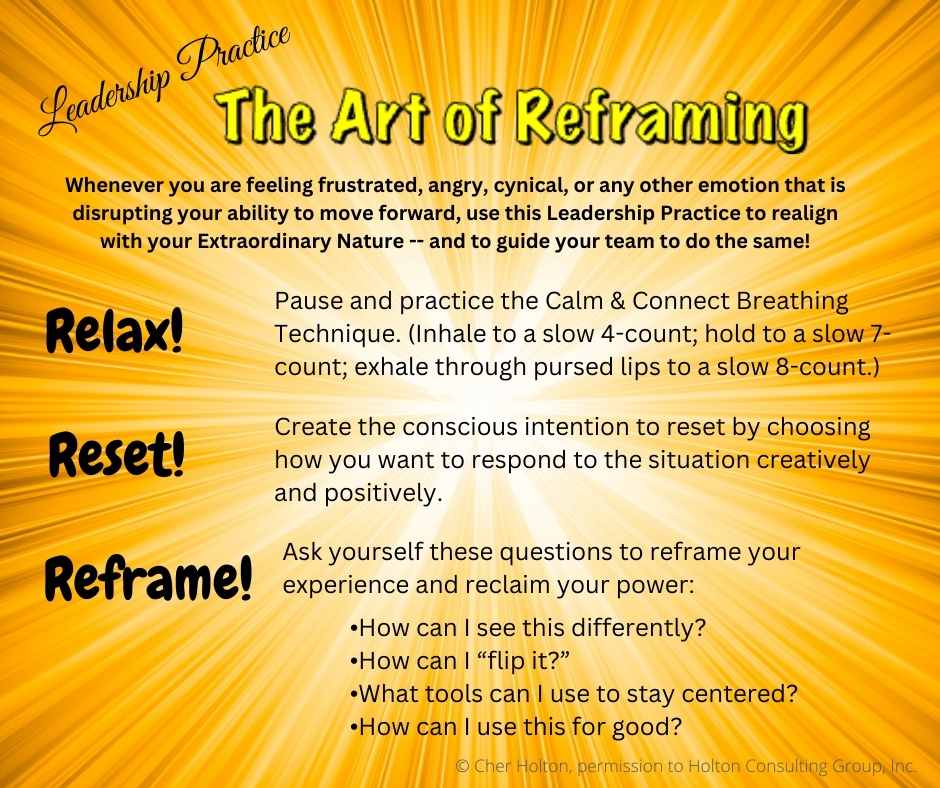
The Art of Reframing:
How Extraordinary Leaders do it!
Extraordinary Leadership Principle: Practice the art of Reframing – and teach it to your people.
WHAT IS REFRAMING?
Reframing is the art of looking at a situation and shifting the way you see it. It is similar to changing the focus on your camera lens, or turning the knob of a kaleidoscope.
When to use reframing
Reframing is a tool to introduce when you or your team is faced with an extremely difficult, frustrating, or dysfunctional situation.
Some examples our clients have faced:
- A leader is filled with dread when faced with giving a very negative performance review.
- A company was faced with dwindling market value because a larger competitor was luring away their clients. The team was focusing on how to compete with this larger competitor with a much smaller budget and fewer resources.
- A luxury car dealership was struggling with how to create a profitable customer recognition weekend event.
(Stay tuned! Later in this article we'll show how Reframing led to successful results in each of these situations!)
How to use reframing
The first step is for you, as an Extraordinary Leader, to recognize that you (and/or your team) is struggling to deal with some situation. You'll notice feelings of being stuck; lots of complaining and finger pointing; excuses about why each idea won't work; and a spiral into deep frustration.
Invite your team to a Reframing Session! During this session, you will brainstorm unique and unusual ways to handle the difficult or frustrating situation, and commit to stay connected with each other and with your customer base.
Here are four important questions to trigger ideas:
How can I see this differently?
For example, ask how you can see this from the viewpoint and perspective of others outside your team (other departments; your clients/customers; your competition; etc.). How is this issue handled in totally different arenas (i.e., how is the concept of competition handled in the world of sports; in the movie industry; in the restaurant industry? How can we take that information and reframe it to fit our situation?
How can I “flip it?”
Look for ways to change the way you talk about the situation. For example, instead of "we can't ..." ask what can we do? Instead of claiming something a market disaster, redefine it as an opening for risk taking and opportunity; instead of claiming that the competition is stealing your clients, ask how you can change the perception of who your clients are and what they need.
What tools can I use to stay focused and centered?
Remember, one of your “Core Abilities” as an Extraordinary Leader is Optimistic Spirit. You recognize the difficulties of the current situation, and at the same time, you know without a doubt there are positive solutions you can implement!
How can I use this for good?
Look at every situation as an opportunity for growth and learning. Get in the habit of evaluating these tough experiences by identifying what you've learned (about yourself, about the marketplace, about your team, about your product/service). Then focus on how you can take what you've learned, and move forward!
Extraordinary Leadership Practice
Here's a poster you can download to remind you of the Extraordinary Leadership Practice of Reframing!

How Did Our Examples Use Reframing?
A leader is filled with dread when faced with giving a very negative performance review.
We worked with this leader to reframe the way he was viewing the situation, by recognizing that performance reviews are opportunities to fix a problem, clarify expectations, and bring performance back on course. We encouraged him to revisit the steps to providing effective feedback, and particularly focus on how he would describe the issue, as well as specific steps to fix it. This also provided an opportunity for this leader to evaluate himself, in terms of how he could do a better job of providing ongoing feedback rather than waiting for appraisal time.
A company was faced with dwindling market value because a larger competitor was luring away their clients. The team was focusing on how to compete with this larger competitor with a much smaller budget and fewer resources.
We worked with this team to flip the conversation, and focus on the benefits and strengths they could bring to the table. They rebranded their vision to highlight their ability to be adaptable, quick to handle issues, deal with clients on a personal level, and provide customized solutions in a timely and affordable manner.
A luxury car dealership was struggling with how to create a profitable customer recognition weekend event.
Our strategy with this group was to guide them to reframe the question they were asking! Instead of "How can we design a profitable customer appreciation weekend event?" they reframed the question to be: "What would make our customers feel appreciated and valued?" As a result of that question, the team created a unique and powerful weekend that has turned into a regular event:
- Based on information about their customers, there was an overwhelming love of pets! So they teamed up with a local pet shelter and sponsored a Love Pets weekend, that offered pets for adoption, pet treats, and specials for customers who brought their pets to take a test drive.